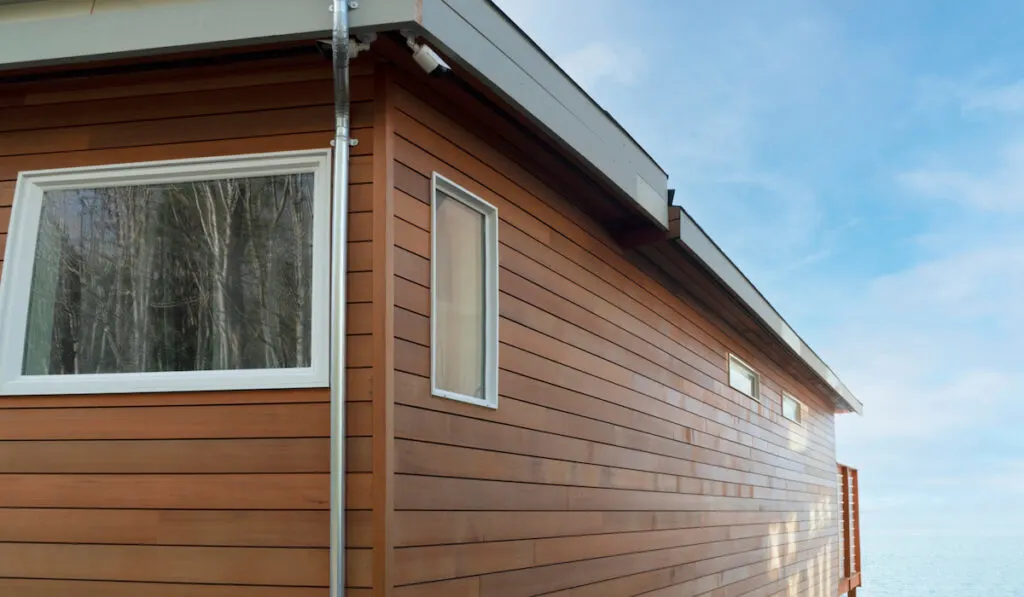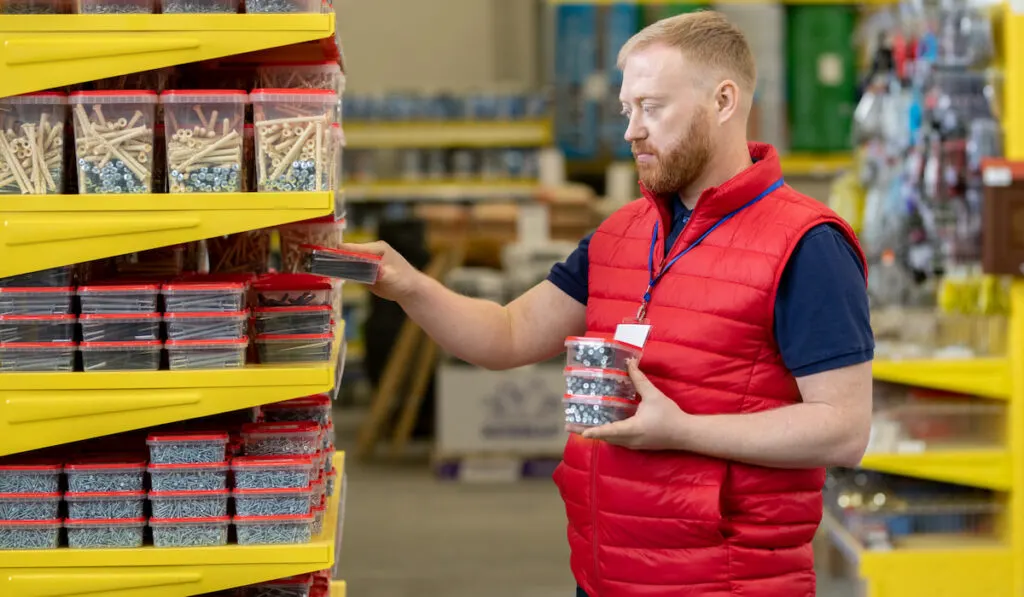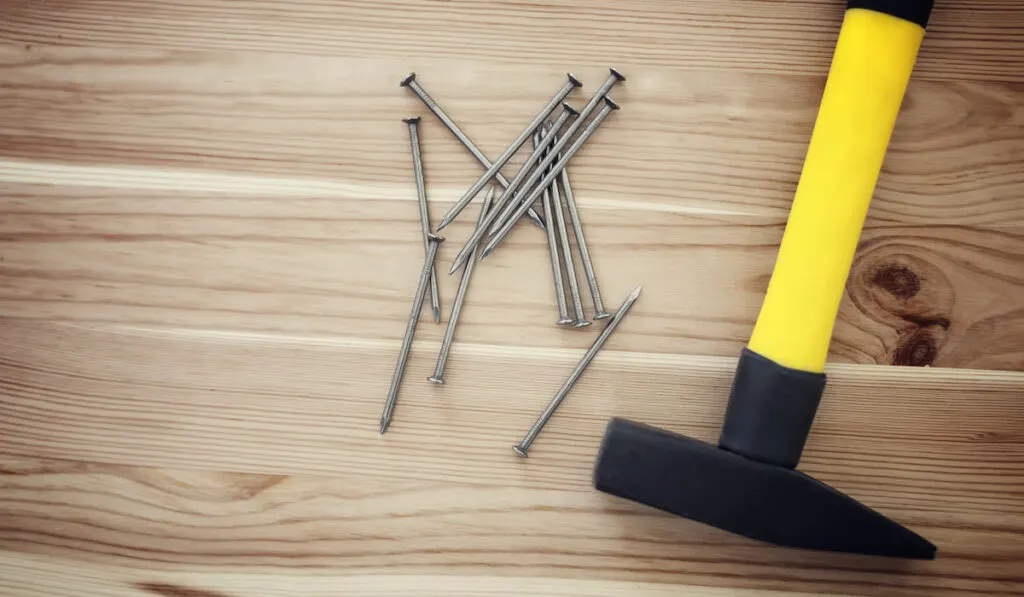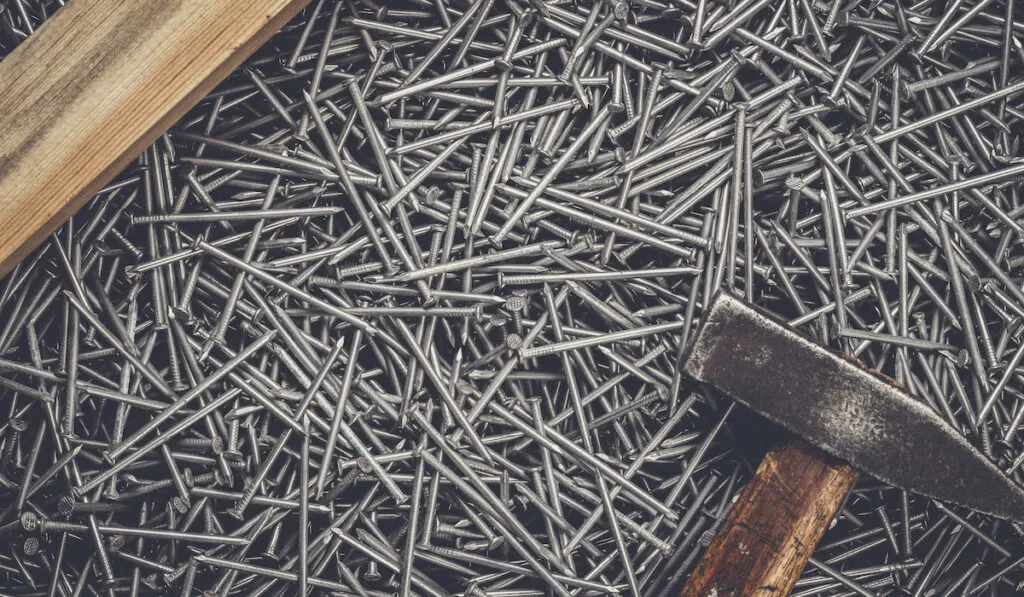*This post may have affiliate links, which means I may receive commissions if you choose to purchase through links I provide (at no extra cost to you). As an Amazon Associate, I earn from qualifying purchases. Please read my disclaimer for additional details.
Your home’s siding is its first line of defense against everything Mother Nature can throw at it. Siding needs to be installed carefully, deliberately, and intelligently. This isn’t something you just want to “wing”.
One of the often overlooked aspects of installing siding correctly is estimating – and then using – the right amount of siding nails. You really need to dial this in without going overboard.
As a general rule of thumb, you’re looking for about 320 nails for every 100 ft.² of siding you’re putting up.

Of course, the specifics of your job, the kind of material you’re using, and a whole host of other factors are going to play a major part in how many siding nails you’ll end up needing.
We get deeper into that below!
Table of Contents
The Important Role Proper Nailing Schedules Play with Siding
A lot of folks – including a lot of professionals in the construction world – are prone to assuming that you can just sort of throw nails into siding without any real rhyme or reason and still get halfway decent results.

Sure, you might be able to get your siding to stick to your house with that approach.
(In the short term, anyway.)
But you’ll soon find out that a random smattering of nails into your siding will cause you a world of headache and hassle that you never could have anticipated.
You see, siding (especially modern siding materials like vinyl materials) require a little more foresight and a little more thought about how they are attached to your home in order to work properly.
Vinyl siding especially likes to have nails driven that allow the siding to sort of breathe and buckle, moving according to temperature and humidity, without ever sacrificing the important protective envelope they provide your home.
Drive those nails too deep in your siding might not be able to move the way it wants to, forcing it to buckle and pop out of place.
Drive those nails too shallow, though, and you might end up with siding that walks right off the walls of your home.
The same can be said about driving too many nails or not driving enough.
Send too many home into your siding material and you’ll end up not just spending a lot more money on nails and you should have, but with siding that doesn’t have the room to move the weight it’s been designed to.
Send home too few, though, and you’ll find bits and pieces of siding slipping off your house sooner rather than later.
How to Know How Many Siding Nails You’ll Need
Estimating the amount of nails you should be using properly right out of the gate is a big piece of the puzzle.
There are a couple of different things you should think about when you are running through this estimate, but there are two core things you need to focus on above all else – and we highlight them below.
Estimating Nailing Needs by Square Feet

For starters, you want to come up with a good “rough estimate” of the nails you’re going to need for your siding by figuring out how many square feet of siding you have two nail home in the first place.
Almost all manufacturers of quality modern siding material are going to tell you how many nails you should use to attach your siding per square foot.
This information is either going to be available directly on the underside of the siding material itself, somewhere in the box, or online.
You’ll be able to find it without too terribly much trouble.
As a general rule of thumb, though, you can usually get away with sending home about 320 nails per 100 ft.² of siding.
Obviously, this rule is not hard and fast – it isn’t poured in concrete – and it isn’t going to work for every single kind of shingle out there.
Vinyl shingles have designated “nailing holes” built right in, and you’re going to want to figure out the nailing schedule and recommended nailing amount per 100 ft.² for those kinds of shingles specifically if that’s what you’re using.
The same goes for all other siding materials – cedar shake, cement board, etc.
As a rough estimate, 320 nails per 100 feet of siding should get you close to where you need to be.
Whenever possible, though, work off of the recommended amount provided by the manufacturer of the specific siding you’re going to be using.
Always Overbuy

At the same time, it’s always – ALWAYS – a good idea to buy more siding nails than you think you’ll need.
We’re not talking about buying pounds and pounds of extra nails just to have laying around the place.
Buy an extra box (or even an extra two boxes) will give you a little more peace of mind than you would have had trying to estimate right down to the very last nail.
It’s inevitable that you are going to find yourself in situations where you have to send home a couple of extra nails here and there just to make sure that your siding is really well attached.
It’s just as inevitable that you’re going to drop a couple of nails, that you’re going to lose a couple of nails, and that you’re going to want to use some of these nails and other places.
Buy a box or two of extra nails and you won’t have to worry about running out, pausing your project to get down to the hardware store, and then starting back up again.
Trust us.
That extra box or two will come in handy for sure!
What Kind of Nails Should I Be Using for Siding?
Now that we have that out of the way, it’s important to hammer home the value in using siding nails specifically designed for siding applications.

Some folks operate under the impression that a nail is a nail is a nail, and that as long as it is long enough to get the job done there’s nothing wrong with using them interchangeably or as universal fasteners.
Nothing could be further from the truth.
Siding nails are almost exclusively hot dipped galvanized nails, nails that have been specifically designed (and treated) for these kinds of applications.
Hot dipped galvanized nails are able to stand up to wind and weather, aren’t going to rust or corrode, and are going to provide you with years and years – decades, even – of reliable usage.
Regular penny nails, for example, might help you tack up your siding. But they aren’t going to hold in the long term and they certainly aren’t going to be able to stand up to the type of conditions that galvanized nails really thrive in.
On top of that, siding nails usually have a nail head specifically designed to fasten that type of siding directly to your exterior sheathing.
Vinyl siding nails have larger heads (they sort of look like roofing nails), whereas nails for fiber cement siding and other options may be a little more narrow and a little more like a finish nail.
At the end of the day, you want to be sure that you are using the right fastener for the job.
Use the kinds of nails recommended by the manufacturer and you’ll have nothing to worry about.

Be Sure to Drive Siding Nails as Straight as Possible
Driving your nails as straight as possible is always important, but it is especially important when you are hanging siding.
Angle your nails one way or another and you’ll inevitably throw off the angle of your siding. You won’t get the full bearing on your fastener that you want, either.
Nails that are angled upwards when they are driven will allow your siding to “droop”. Nails that are angled downwards when they are driven will hold your siding higher than it should be.
Drive those nails just as straight as you can get them and you’ll have a whole lot less to worry about.
Give Room for Siding to “Breathe” When Nailing It Off
We mentioned this earlier but it’s important enough to mention again:
Make sure that you follow the specific nailing schedule outlined by the manufacturer of the siding you are using.
There’s always going to be a temptation to want to use extra nails, just to make sure you get a real tight and permanent fit.
The trouble here, though, is that (like mentioned earlier) siding wants to move and shift – especially when you’re talking about a vinyl siding and wooden siding.
If you try to nail that home permanently without any “wiggle room” you’ll end up causing a lot more trouble for your siding than you would have leaving plenty of room to breathe and allowing your siding to move as it wants to naturally.
Trust us on this one!

Closing Thoughts
At the end of the day, it’s always a good idea to follow the manufacturer’s recommendation when you are estimating how many nails to buy for your upcoming siding project.
As a general rule of thumb, though, about 320 nails per 100 ft.² of siding should get you all the nails you need with a couple left over at the end of the day.
Don’t be shy about overestimating, either!
Having too many nails at the end of a siding project is a much better problem than being halfway through and not having enough to finish the job.
Resources
- https://modernize.com/homeowner-resources/siding/proper-nailing-vinyl-siding
- https://allpointconstructionmi.com/many-roofing-nails-per-square/
- https://www.lowes.com/n/buying-guide/choose-nails-for-your-project
- https://cementanswers.com/how-many-siding-nails-do-i-need/
- https://www.manasquanfasteners.com/fastener_estimator
- https://findanyanswer.com/how-many-siding-nails-do-i-need
